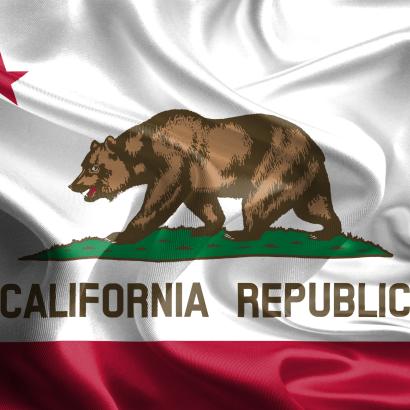- State & Local
- Campaigns & Elections
- Empowering State and Local Governance
California’s budget went from an assumed $98 billion surplus, in which there was so much cash in state coffers that Gov. Gavin Newsom was giving away $50,000 to randomly selected individuals to get a COVID-19 vaccine, to a projected $73 billion deficit in only about two years.
Much of this could have been avoided if, in 2022, California hadn’t made obvious, enormously unrealistic revenue assumptions for future years that falsely painted far too optimistic a fiscal portrait for the state. In a nutshell, here is what happened: in fiscal year 2021‒22, state tax revenues rose around 55 percent—about $70 billion—over the previous fiscal year. This revenue windfall significantly reflected taxpayers realizing capital gains, particularly high-income taxpayers who were facing a marginal tax rate of 13.3 percent at the time.
For decades, California’s revenues have been driven by a capital gains roller coaster in which revenues spike in years in which the stock market booms and investors sell stocks and other assets, after which capital gains revenues decline. The 2021‒22 fiscal year was the mother of all capital gains roller coaster peaks. It seems obvious that the revenue roller coaster would decline after that, particularly with the stock market falling about 23 percent between the end of 2021 and mid-June 2022, when the 2022‒23 fiscal year budget was signed.
However, Newsom’s budget staff assumed that the revenue bonanza from 2021 would not just continue but would grow to an even bigger bonanza in future years. These revenue assumptions were patently unrealistic, particularly with the long-standing history of capital-gains revenue crashes following booms and with the stock market declining considerably in real time during the first half of 2022.
Despite this, Newsom’s staff predicted revenues for fiscal years 2022‒23 and 2023‒24 that were roughly $80 billion higher than what was realized.
To put the 2022‒24 revenue prediction errors in perspective, New York is the only state that had a general fund budget at that time exceeding this error.
These unrealistic assumptions led Newsom in June 2022 when he signed the budget to state that “No other state in American history has ever experienced a surplus as large as this.” But when reality bit, it bit hard, and the ephemeral surplus morphed into a deficit.
In this year’s budget proposal, Newsom’s revenue assumptions for the future have declined enormously, by about $40 billion less per year. And this is an important factor driving the Legislative Analyst’s Office to forecast a $73 billion budget deficit for fiscal year 2024‒25.
Another key factor driving the deficit forecast is that our current budget, which ends at the end of next month, was based on these erroneous assumptions and consequently rose far too much. Spending increased about 63 percent in the last five years to over $320 billion in the current fiscal year. By comparison, the 1964‒65 state budget, which was during the heyday of California’s population growth (California’s population rose over 25 percent in the decade of the 1960s), was $2.35 billion.
If the 1964‒65 budget had grown to accommodate population growth and accounted for inflation, then it would be just $38.6 billion today. Even tripling that amount to allow for higher quality and/or higher cost public goods and services now than were purchased back in the day would leave the budget at about $116 billion today, compared to the actual budget of more than $320 billion.
Having substantially overspent in previous years, Newsom and the Legislature must now cut many programs to achieve a balanced budget for fiscal year 2024‒25. Newsom’s latest budget proposal for 2024‒25 calls for cutting hundreds of programs and using about $12 billion in reserves, nearly half of the reserve account, in a $288 billion budget. The latest budget proposal omits any discussion of how such enormous revenue assumptions were made in previous years.
Newsom’s revised proposal cuts high-return investments in broadband internet for poor communities, which includes installing high speed internet for public libraries in rural areas, and programs for foster kids. In addition, there are long-standing deficiencies within the state, including $70 billion in deferred maintenance.
As programs are being cut, debates about budget priorities come to the fore. One spending area receiving significant pushback is Newsom’s plan to fund health care for all low-income people, irrespective of their immigration status. This program, which has not been cut, this would cost upwards of $3 billion per year and would include around 700,000 illegal migrants.
Given the number of illegal border crossings at the southern border in recent years, immigration is viewed as the number one problematic issue facing the country, according to a recent Gallup poll. And with a promise to provide free health care to all low-income people, it is perhaps not surprising that San Diego now has the most illegal border crossings of any location along the southern border.
California’s Legislature now has about four weeks to finalize a 2024‒25 budget with Newsom. There is one silver lining to the budget reduction, which is that proposed legislation to create a state-run single payer health care system, which would outlaw private insurance and replace Medicare, was killed due to its budget implications. Assembly Bill 2200, the “Guaranteed Healthcare for All” Act, would perhaps cost over $500 billion per year.
Even though nearly all Californians have health insurance (92 percent in 2022), the advocates for this bill want the state to pay for all health care for everyone, with a focus on health care equity. Eliminating AB 2200 is a big positive because I see no chance that the state could ever realistically run such a program, given its many administrative failures over time, ranging from the Department of Motor Vehicles, which was called a “car wreck of a bureaucracy” in 2019 by the San Francisco Chronicle, to the dysfunctional Employment and Development Department, which paid out $32 billion in fraudulent unemployment claims during the pandemic, failed to pay legitimate claims, and couldn’t answer the phones.
It is a sad situation when a budget crisis is needed to stop bad government. But this is California.

















